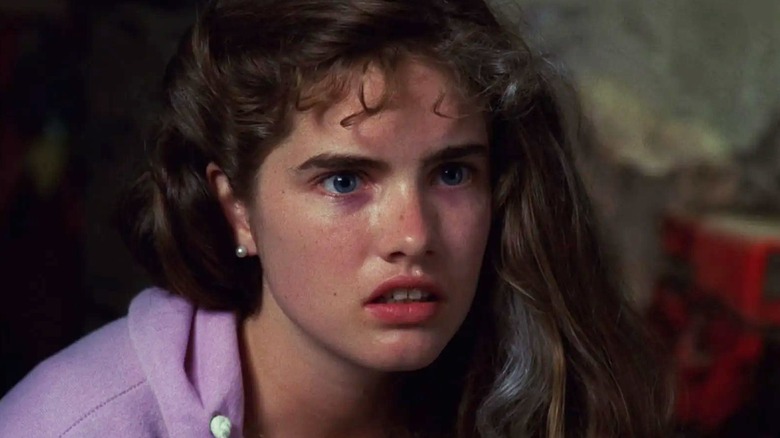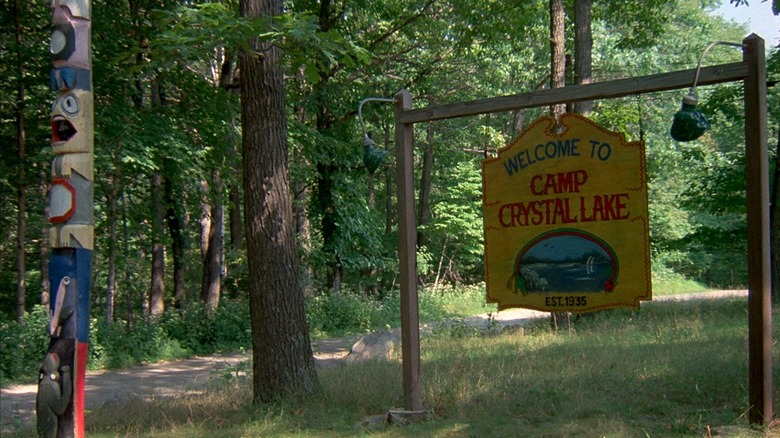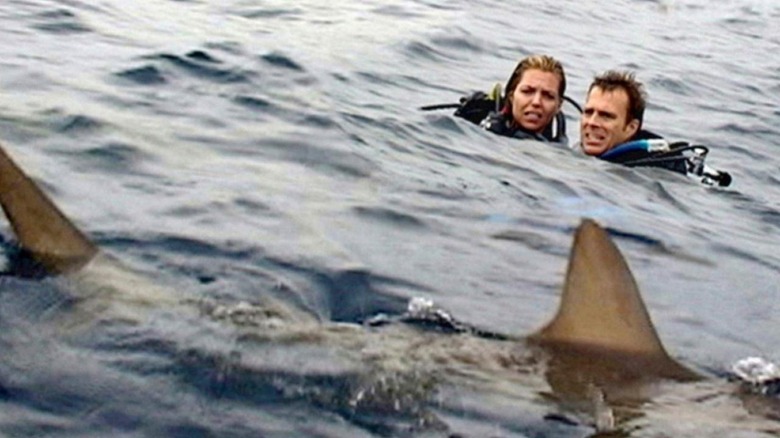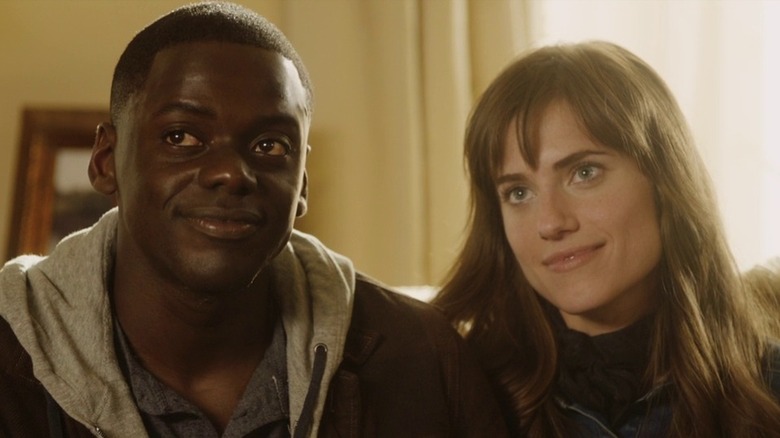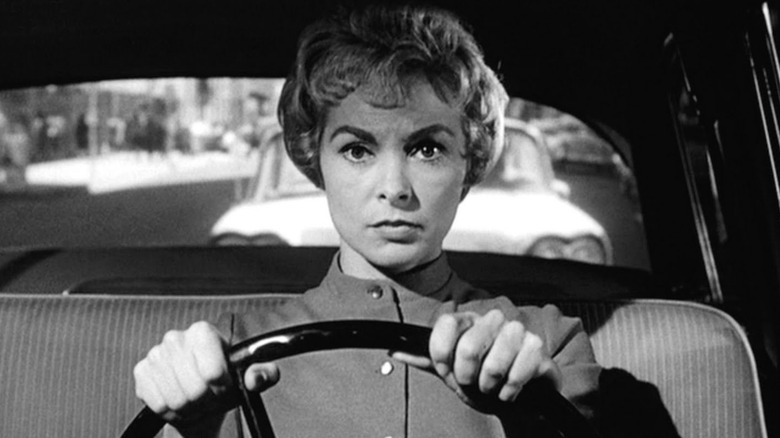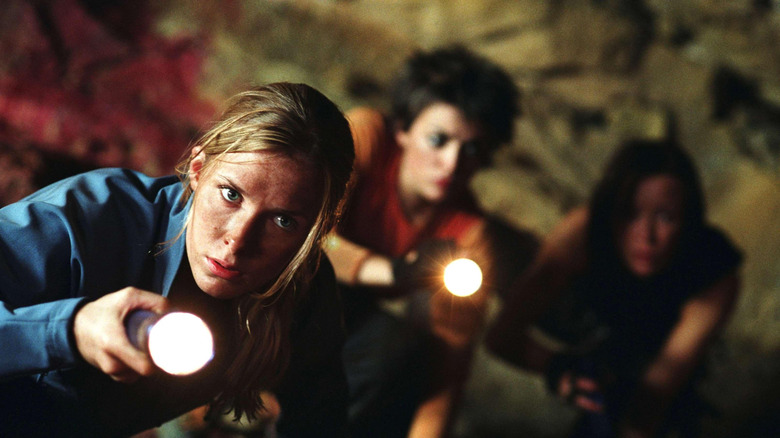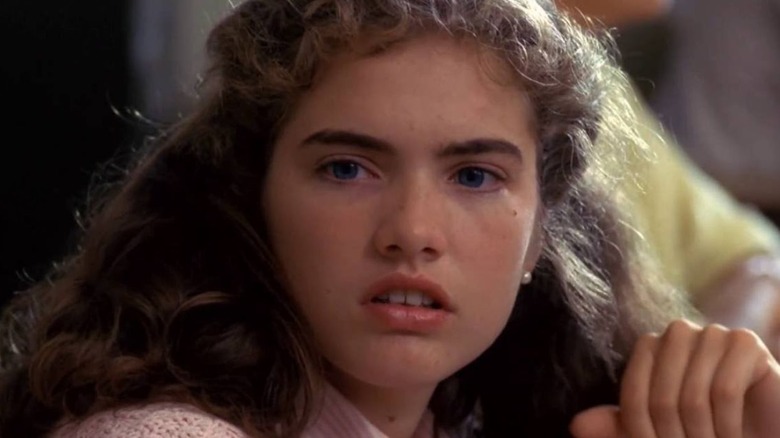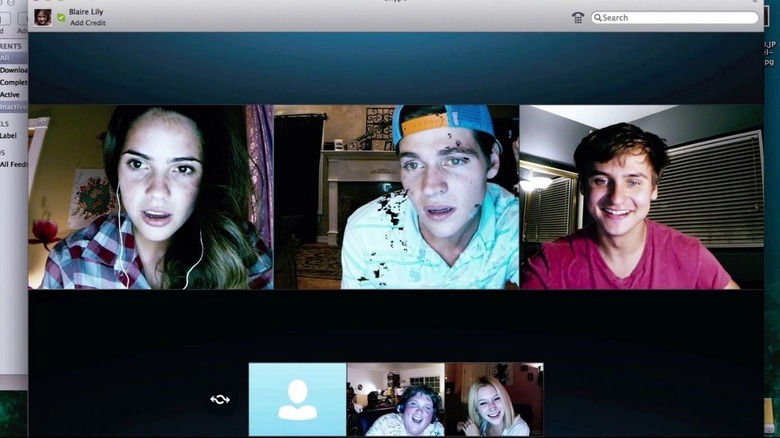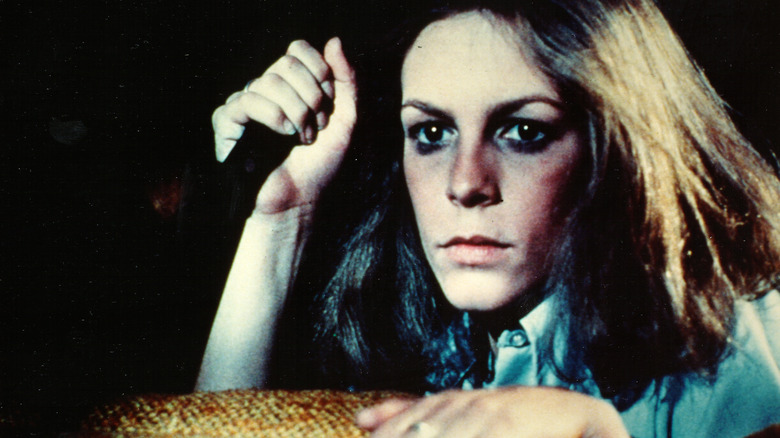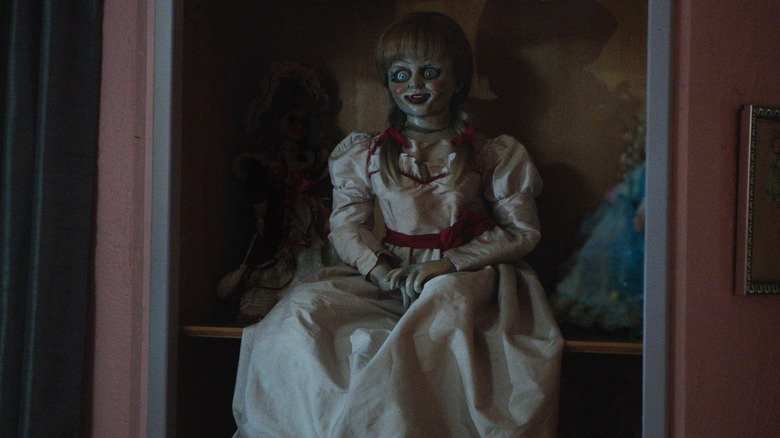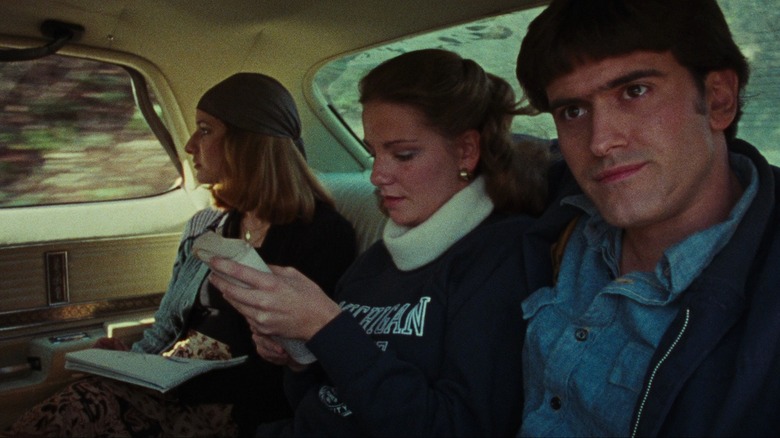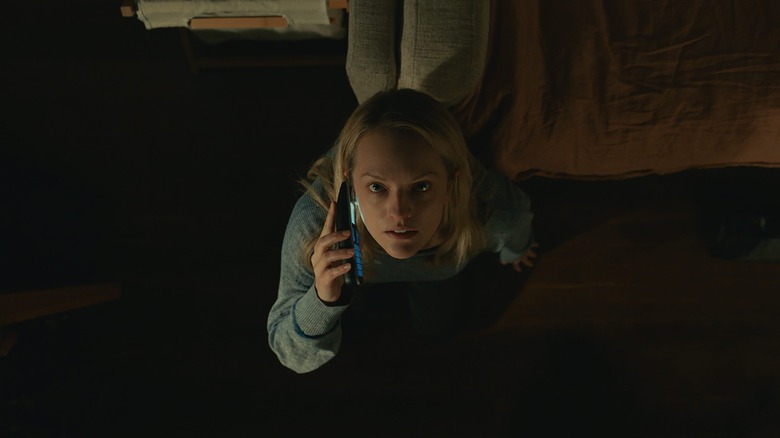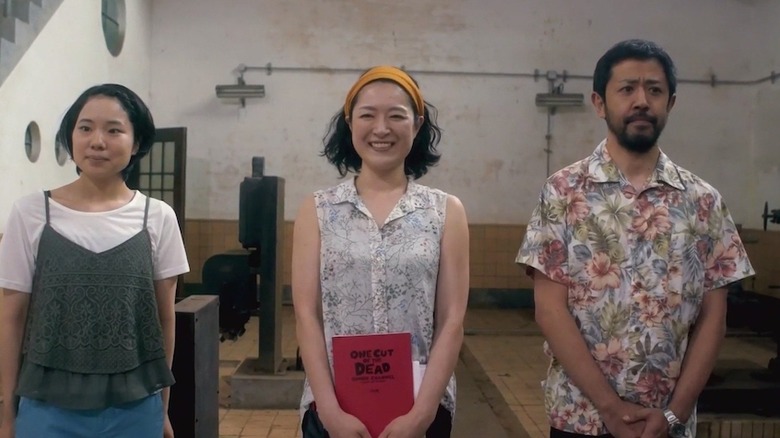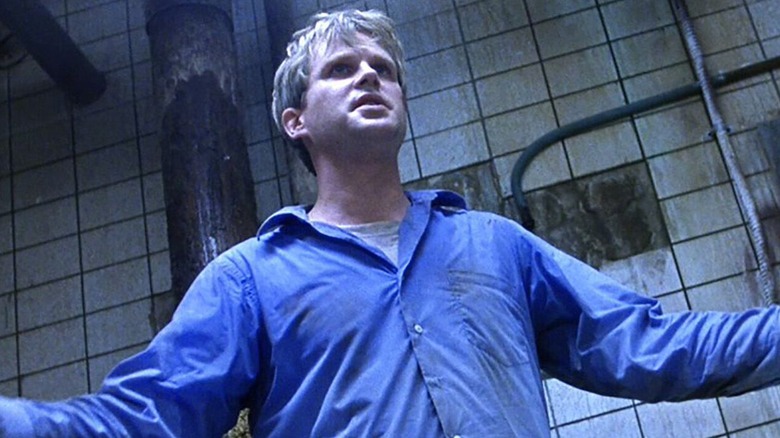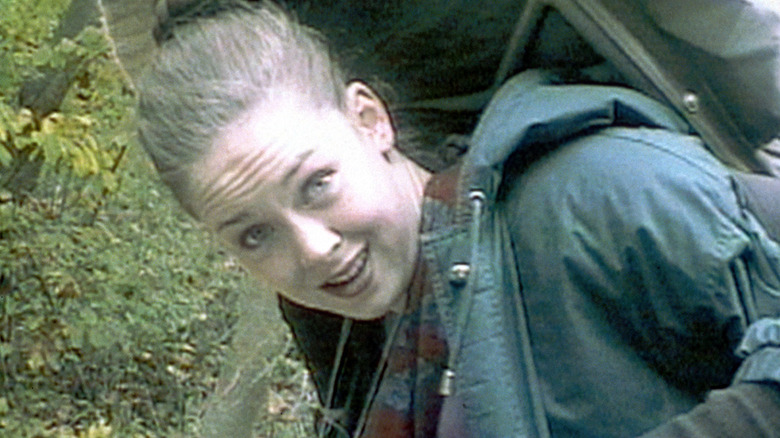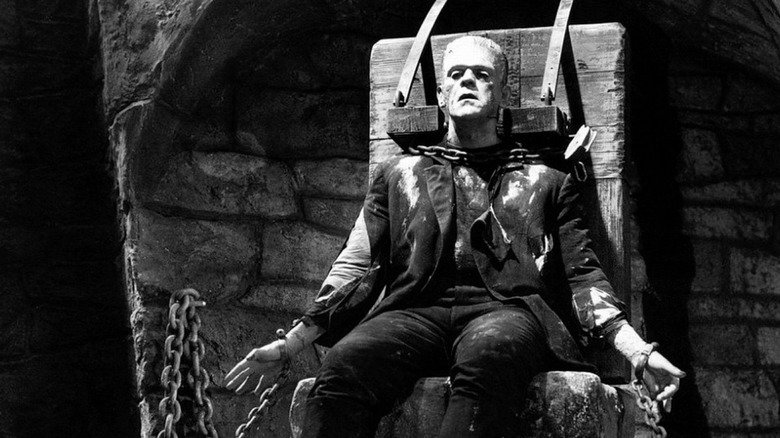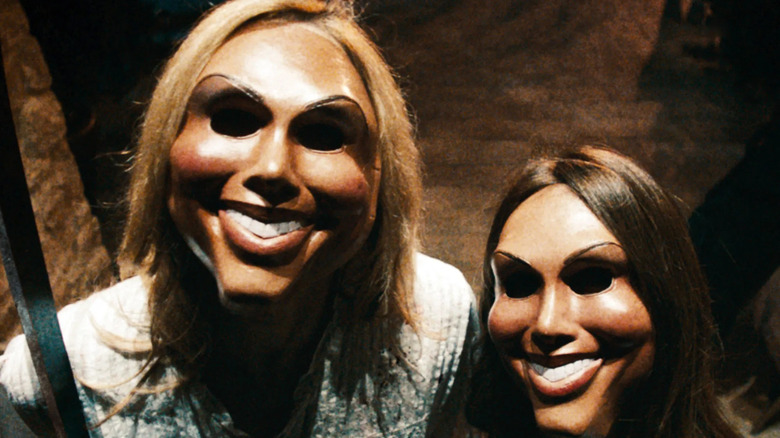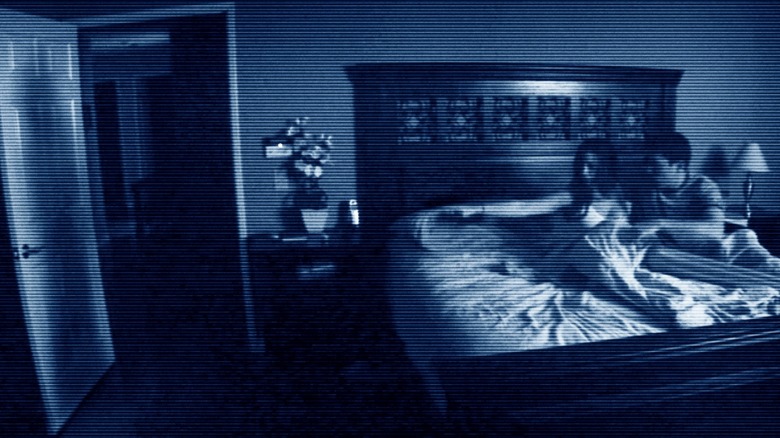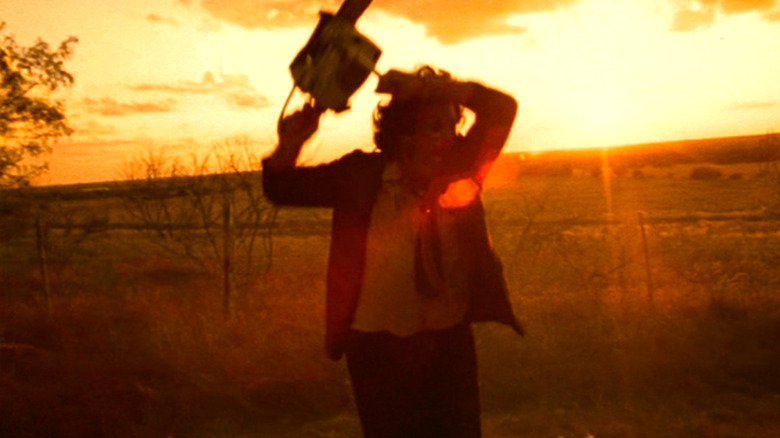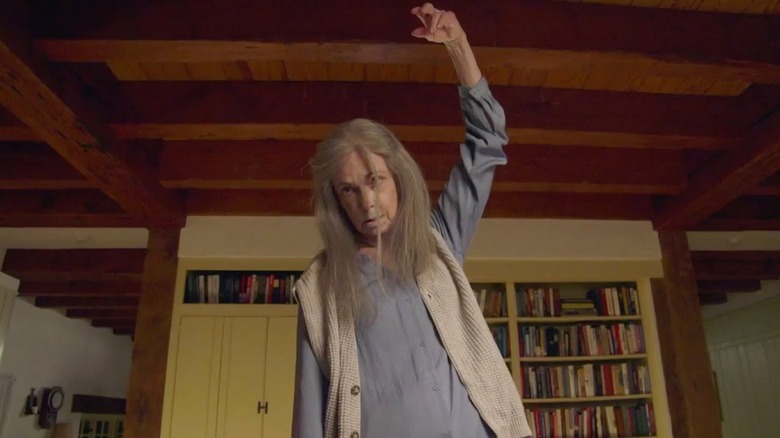Low Budget Horror Movies That Made Millions
Horror movies for the most part tend to have microscopic budgets. Even relatively speaking, considering most mainstream movies cost many multiples of millions to get off the ground. With that said, some horror movies go on to make a tidy sum at the box office, while others make a downright killing.
These 19 horror titles took home box office returns many times larger than their budgets, sometimes shattering records and absolutely obliterating people's expectations. Enjoy this list that was painstakingly compiled by the /Film team comprising what we like to think of as the little frights that could.
Friday the 13th (1980)
Inspired by the success of John Carpenter's "Halloween," Sean S. Cunningham and Victor Miller concocted a story about a group of teenage camp counselors who are murdered one by one by an unseen killer just weeks before the reopening of an abandoned summer camp.
Originally titled "A Long Night at Camp Blood," the film that would become "Friday the 13th" was shot on a budget of only $550,000 and sparked a bidding war over distribution rights between Paramount Pictures, United Artists, and Warner Bros. Paramount eventually won the rights to the film, nabbing "Friday the 13th" for $1.5 million dollars. The studio knew they had a hit on their hands and put approximately $500,000 into the movie's advertising budget. They later added an additional $500,000 for a total of roughly $1 million spent on marketing when it started killing it in theaters.
Paramount was smart, and their investment paid off, as "Friday the 13th" brought in a whopping $59.8 million at the box office. Adjusted for inflation, the film brought in over $203 million by 2022 standards, making it the highest-grossing horror film of 1980. The massive success at the box office sparked a franchise, with every installment except "Jason X" making at least 3x its budget at the box office, and "Friday the 13th Part V: A New Beginning" making 10x its budget. When "Friday the 13th" was given the remake treatment in 2009, the film was shot on a budget of $19 million but brought home $92.7 million at the box office, proving that while the franchise as a whole has delivered mixed returns as far as quality, "Friday the 13th" is a guaranteed way to slash up the box office.
Open Water (2003)
"Open Water" is a sadistically-engineered early aughts nightmare from the mind and lens of writer-director Chris Kentis. Therein, Susan Watkins and Daniel Kintner (so named for the fictional Watkins and Kintner who became lunch in Steven Spielberg's iconic creature feature "Jaws") end up stranded in the big blue Pacific, as the title states, when their scuba diving guide crew raised anchor and departed back to shore without doing a proper headcount. Bit by bit, dehydration, hunger, and exposure creep in, and that's before the first shark fin glides into the frame.
Little actually happens over the next hour and a half of runtime, and so the dread descends onto the viewer as steadily as hypothermia might set in, and the result is devastating. Shot on digital on an economical budget of $500,000, "Open Water" made out like a bandit with a domestic opening of $1,100,943 and a lifetime gross of $55 million. A mouse-quiet survival movie about a long, salty swim became a runaway hit, but why?
Roger Ebert credits it to a simple, universal fear of abandonment. "I'm not afraid of water and don't spend much time thinking about sharks," wrote the acclaimed critic in the Chicago Sun-Times, "but the prospect of being lost, of being forgotten about, awakens emotions from deep in childhood. To be left behind stirs such anger and hopelessness." Further fueling the film's popularity was its loose connection to true events: the story is based on the 1998 disappearance of American couple Tom and Eileen Lonergan, whose guide crew had not noticed their absence until two days after they failed to return to the dive boat in the Coral Sea.
Like so many horror movies based in reality, "Open Water" offers a cosmic middle finger in lieu of a happy ending, which was just what the post-9/11 crowd ordered.
Get Out (2017)
"Get Out," Jordan Peele's directorial debut, was made with a modest budget of $4.5 million dollars. It starred then-unknown actor Daniel Kaluuya, offered an unflinching depiction of racism, and didn't rely on gore or expensive visual effects to attract audiences or generate scares. Against the odds, the psychological horror-thriller created by 50% of the "Key and Peele" duo would go on to earn over $255 million worldwide. Much of the film's success is due to good old-fashioned storytelling, as it draws on the realistic horrors and relatable anxieties associated with meeting your partner's parents and being the only Black person in a room full of white people.
The film's use of casual and systemic racism as the main villain during what would become an era fraught with racial tension was also particularly timely. While the original ending had Chris being arrested and imprisoned after defending himself against Rose and her family, Peele decided to rewrite it after several high-profile police brutality cases sparked meaningful conversation on the pervasive nature of racism in modern society. In the new ending, Chris — and the audience — would experience a knowing moment of despair when the police car arrives, only to breathe a sigh of relief when his friend Rod (Lil Rel Howery) steps out of the car to rescue him. According to Peele, this ending allowed for the originally intended reaction to be preserved while still allowing for a happier ending, relatively speaking.
In addition to good storytelling and timeliness, the massive critical and financial success of "Get Out" can also be attributed to the fact that its concept of "the sunken place" became a viral sensation, sparking memes and becoming part of the cultural lexicon as a popular term for silence and complacency in the face of systemic oppression. Despite being technically low-budget, the film's solid execution and boldness in forcing audiences to acknowledge the reality of racism definitely paid off in a big way.
Psycho (1960)
Alfred Hitchcock's 1960 classic is a low-budget success by design. The Master of Suspense was rumored to be growing bored with the lack of challenge his bigger-budget projects presented when he purchased the rights to the novel that would be the basis for "Psycho." In the documentary "The Making of Psycho," the film's screenwriter, Joseph Stefano, says that Hitchcock had a clear vision for a low-budget hit when he pitched the movie, one he presented with a signature Hitchcockian diss. The filmmaker cited some other recent black-and-white hits, then said, "How would it be ... if somebody good did one of these low-budget movies?"
Hitch relished a challenge, and "Psycho" was just that. According to an IndieWire retrospective, he made the movie for around $800,000. The director cut costs by filming in black-and-white with a television crew. The film's lack of color was a striking choice that also made practical effects easier, as when Hitchcock famously used chocolate syrup to create fake blood in the film's famous shower scene.
His gamble paid off. "Psycho" made at least $32 million at the box office, though its historic run is often cited as raking in upwards of $50 million. With adjustments for inflation, "Psycho" grossed around $400 million during its theatrical run. This turned out to be a lucrative payoff for the director. When he initially pitched the project to Paramount, executives weren't entirely convinced the lurid tale would pay dividends. Hitchcock was so confident in his project that he chose to forgo his typical salary in favor of 60% of the film's gross.
Hitch returned to bigger-budget projects after "Psycho," but his detour into shoestring filmmaking is forever immortalized in a masterpiece that was able to terrify audiences for little more than the cost of a jar of chocolate syrup.
The Descent (2005)
Every now and then, a low-budget, under-the-radar horror pic starts generating the type of buzz that results in smashing success. In 2005, Neil Marshall was known — if he was known at all, really — as the director behind the horror-comedy "Dog Soldiers." Marshall's follow-up was "The Descent," the story of a group of female cave divers who run afoul of some slimy, screamy, subterranean monsters. Marshall plays up the friendships and the rifts between the characters, adding to the tension while making us genuinely care about whether or not everyone will make their escape. The film looks plenty slick, but the limited location (a dark, damp, claustrophobic cave, created entirely on a set at Pinewood Studios), coupled with a fairly unknown cast helped keep the budget relatively low (under $5 million, to be precise).
"The Descent" first opened in the U.K. in 2005, but a year later, it made its way to the Sundance Film Festival, where it earned rave reviews and plenty of hype. By the end of 2006, "The Descent" was making plenty of "best movies of the year" lists. It was also a major hit, hauling in $57.1 million against a budget of £3.5 million (about $4,702,477.50 in American dollars).
Those are the types of numbers that immediately get people saying "Sequel!" And sure enough, "The Descent 2" arrived in 2008. And it should be completely ignored because it stinks and ruins much of what made the first film's simple-but-effective set-up so special.
A Nightmare on Elm Street (1984)
It seems impossible nowadays that horror classic "A Nightmare on Elm Street" could be described as low-budget, but in 1984 when it was released, that's exactly what it was.
According to a 2015 Vulture interview with Bob Shaye — producer and founder of New Line Cinema — the film started off with a $700,000 budget, which quickly boiled over to $1.1 million (which, adjusted for inflation, is approximately $2.68 million in today's world, and still considered low-budget). What could've been just another dead-end horror gag turned out to be a bonafide phenomenon, and Wes Craven's horrific high school tale ended up grossing a whopping $51 million globally. Adjusted, that number would be over $137 million in 2022. The film was such a roaring success that it ended up pulling New Line Cinema out of the financial straits they'd been in since their 1967 creation. The company had renegotiated their debts in 1980 but were still trying to keep their heads above water when "A Nightmare on Elm Street" made the studio's dreams a reality.
It doesn't take a rocket scientist to see why this movie did so well when it was first released, and subsequently, why it continues to have a major influence in the genre to this day.
Two words: Freddy Krueger.
The villainous monster — who is really the unkillable, dream-traversing specter of a local killer — hooked the audience with his unrelenting menace and his quippy yet nasty one-liners. Thanks to Robert Englund's star-making performance, this small horror trial became one of the most well-known entries the genre has ever seen, with the box office return to prove it.
Unfriended (2014)
When talking about microbudget horror films that shined bright at the box office, it goes without saying that "Unfriended" is one of them. Ingeniously executed, it is one of the first major screenlife horror films — it plays out entirely on a MacBook screen. It tells the story of digital possession caused by cyberbullying, where six high school students are joined by an unknown, mysterious user during a Skype session. When the sinister entity is revealed to be their classmate Laura Barns, who took her own life a year earlier, the teens begin dying one by one — and heinously, might I add. They can't hide, they can't log off, and they're forced to make harrowing confessions and watch as the spirit takes over their Facebook accounts, posting incriminating footage that ties them to her death.
Directed by Levan Gabriadze, the film had its world premiere at the Fantasia International Film Festival in 2014 before Universal Pictures released it theatrically a year later. Against its humble $1 million-dollar budget, "Unfriended" was highly successful at the box office and grossed $62 million worldwide. Its $15.8 million opening weekend was the biggest debut for an original horror movie since "The Conjuring" in 2013, and its success is credited to its originality and creative marketing campaigns.
After "Unfriended" premiered at SXSW Film Festival, the attendees were "friended" by the official Laura Barns Facebook account (the same that threatens the characters in the film). "Unfriended" was embraced by horror fans thanks to its truly original and simple execution. Being intruded on by the ghost of your dead friend is horrifying enough.
If you or someone you know is struggling or in crisis, help is available. Call or text 988 or chat 988lifeline.org
Halloween (1978)
John Carpenter is an undisputed master of horror, and if the man has a single crowning achievement, it is most likely 1978's "Halloween," the slasher classic that introduced the world to Michael Myers and spawned a franchise that is still going strong to this day. Carpenter co-wrote the movie alongside producer and frequent collaborator Debra Hill. At the time, the slasher genre as we know it today wasn't really a thing, though movies like "Psycho" and "Black Christmas" were arguably two of the first in what would become the subgenre. "Slasher" wasn't a term at the time, and that needs to be understood when looking at what Carpenter did when he was approached to make a movie about a killer stalking babysitters: it wasn't a template for success. Especially when you consider that it was made on a budget of $325,000.
Thanks to some compelling marketing that leaned heavily on the title (and left things pretty mysterious), "Halloween" went on to become one of the most profitable horror movies in history. To date, it has earned just over $70 million at the box office, which is more than 230 times its original budget. Those kinds of returns simply don't happen in Hollywood.
The real value here is the franchise it created, with Jamie Lee Curtis anchoring much of it as Laurie Strode, who has become a true genre icon. The films have earned more than $700 million collectively at the global box office across 12 entries, with even more on the way. That's bloody good business.
Annabelle (2014)
James Wan's 2013 film "The Conjuring" was a massive hit, taking in $317 million and using the reportedly true stories of Ed and Lorraine Warren to develop a franchise around memorable supernatural villains. That film interestingly begins with the introduction of a possessed doll named Annabelle, a distributing figure that made such an impression (despite not being the film's antagonist) that it got its own spin-off merely a year later.
2014's "Annabelle" focuses on the doll itself via its connection to a vicious Satanist attack intended to conjure a powerful demon. According to an interview with director John Leonetti, the film was intended as part of a strategy to spin new projects out of successful films and their existing fan bases. Making an extraordinary $257 million in box office returns on a mere $6 million budget, the strategy worked: the movie cemented the "Conjuring" universe films as top performers and kept the eerie doll in the spotlight.
A number of factors contributed to the rampant box office earnings "Annabelle" made. The doll was reportedly so frightening that cast members avoided it on-set. Between that and its reportedly true backstory, there was strong material for their new spin-off strategy. Premiering so soon after "The Conjuring" gave it some additional advantages, as fans were still hungry to revisit that world. Finally, early reports of a number of on-set supernatural events only added to the movie's creepy notoriety.
While "Annabelle" wasn't as critically well-received as its 2013 progenitor, the unsettling doll at its heart (and its eerie real-life origins) proved sufficiently unforgettable to stand out at the box office while sparking a whole series of sequels.
The Evil Dead (1981)
There's low-budget filmmaking, and then there's "The Evil Dead." The original cabin in the woods horror film was made completely independently, with writer and director Sam Raimi begging anyone he could to finance his film. He ended up raising $375,000 — about $1.3 million with inflation — and headed to rural Tennessee to film their low-budget gore-fest.
"The Evil Dead" was like a filmmaking boot camp for many of its young crew, including the 20-year-old Raimi and one of his oldest pals, star Bruce Campbell. They endured a grueling shoot in the Tennessee wilderness that eventually forced crew members to leave one by one. In the end, it was only Raimi and Campbell working late into the night on their demented dream. Thankfully, it was all worth it, as "The Evil Dead" went on to gross $2.4 million at the box office, which is about $8 million with inflation. That means "The Evil Dead" made back six times its budget just at the box office, and that's not accounting for its eventual home video release.
Cult classics like "The Evil Dead" do even better on video, and this low-budget nasty was no different. Fans who couldn't see it in theaters because of its NC-17 rating sought it out on VHS. In 1987, it spawned a sequel, "Evil Dead II." From there, Raimi created an entire franchise that has grossed more than $150 million worldwide. The film's frenetic energy, unusual camera techniques, and gross-out gore made it an all-time midnight movie classic.
The Invisible Man (2020)
Leigh Whannell knows his way around a low-budget horror success story as not only the screenwriter for the first two "Saw" films but also as the writer and director of 2020's "The Invisible Man." Shot on a modest budget of $7 million for low-budget horror juggernaut Blumhouse Productions, the modern adaptation of the classic horror film exceeded all expectations and took home $143.1 million. It was the top of the box office during its opening weekend and enjoyed a successful three weeks in theaters until COVID-19 struck, and theaters around the globe shut down. In the subsequent weeks, "The Invisible Man" continued to play almost exclusively at drive-in theaters and reclaimed the top spot at the box office during its 16th weekend when physical media and VOD rentals were already available.
The same week that the United States box office reported a $0 opening weekend in March of 2020, the on-demand streaming service FandangoNOW reported their biggest weekend in history with "The Invisible Man" at the top of the most-watched list with a $19.99 rental price tag. While VOD numbers are not reported, we do know that "The Invisible Man" brought home approximately $13,220,396 in domestic sales of DVD and Blu-ray, proving that audiences really, really wanted to see "The Invisible Man."
The film is genuinely magnificent and an absolute masterclass in horror, so it's no surprise that the film was a success. It's safe to assume that "The Invisible Man" would have performed even better had the theatrical run not been forced to end prematurely, but its impressive box office run in the midst of a pandemic makes it all the more impressive.
One Cut of the Dead (2017)
Pom!
It's not an exaggeration to say that no one was expecting "One Cut of the Dead" to come crashing into the horror space like a feral cannibal. Upon first glance, Shin'ichirô Ueda's movie seems like a routine microbudget zombie picture. Made for ¥3 million (about $25,000 in Yankee currency), the story surrounds a production team and cast who are assigned to make a single-take zombie movie for live TV. It's a tall order for filmmakers with the limited resources these ones have; they don't even have money for an air compressor, and theatrical blood must be manually blown through a tube for splatter effects. But this team has the power of cinema on its side, and they pour their blood, sweat, and tears (and maybe some other bodily fluids) into a scrappy movie that would surely have zombie cinema pioneer George A. Romero nodding in approval. The first half-hour of "One Cut of the Dead" walks the same well-trodden path of the usual zombie outbreak tropes and does it so well that, before the turn, one might shut off the movie and miss out on the incredible narrative pivot that occurs, taking a ho-hum zombie story template and transforming it into a heartfelt, goofy love letter to movies and filmmaking.
The payoff was immense: audiences fell head over heels for the movie, to the tune of a worldwide gross of $27.5 million. The movie went on to become the seventh highest-grossing film in Japan in 2018 and is currently enjoying extended praise on underrated horror streaming service Shudder.
Saw (2004)
When "Saw" premiered in 2004, director James Wan was an unknown name in the film industry. After writing the script with his friend and fellow filmmaker Leigh Whannell, "Saw" was produced for just $1.2 million. Despite this tiny budget — which was small even by horror movie standards — "Saw" went on to become a massive financial success, grossing over $103 million globally. The success and subsequent popularity of the "Saw" franchise can likely be attributed to the fact that it offered a refreshing take on scary movies, so much so that it is often credited with revolutionizing the horror genre as a whole.
One element that set "Saw" apart from other horror movies of the era is the fact that it deviated from the popular "teen slasher" formula. In fact, the main characters aren't teenagers at all, and there's no campiness or fan service to offset the film's unfiltered violence. Additionally, the movie's villain wasn't a supernatural phantom or a mindless murderer. Instead, "Saw" introduced the world to Jigsaw: a sadistic gamemaster and serial killer who uses his victims' own survival instincts and morality against them. The "moral dilemma" aspect worked alongside the extreme body horror present throughout the film to evoke a visceral response that made "Saw" unforgettable to viewers and critics alike.
The movie's apparent uniqueness did not go unnoticed by Lionsgate, the film's distribution company, which is another factor in its success. After the film's positive reception at the 2004 Sundance film festival, Tim Palen, the marketing co-president of Lionsgate, pushed for "Saw" to receive a theatrical release rather than going straight to DVD, as was originally intended. Lionsgate CEO Jon Feltheimer took things a step further by moving the film's October 1 release date to October 29 in order to take advantage of movie goers' increased appetite for horror on Halloween weekend.
The Blair Witch Project (1999)
Daniel Myrick and Eduardo Sánchez's faux-documentary all but reinvented the horror genre overnight when it debuted in 1999. "The Blair Witch Project" popularized the found footage format and ushered in an era of dread-based, less-is-more horror that would dominate the 21st century. Along the way, it became one of the best box office success stories of all time. Before post-production and marketing costs, which bumped the film's cost up to as much as half a million dollars, the project was originally shot for a minuscule budget of around $35,000.
"The Blair Witch Project" made massive box office returns after a successful viral marketing campaign convinced viewers it might contain real footage of actual missing people. The movie grossed nearly $250 million worldwide, benefiting from word of mouth among viewers who bought into the urban legend at its center. The film's success paid for its initial budget several hundred times over.
Unlike some films on this list, the shoestring elements of "The Blair Witch Project" are easy to see. The film's grueling shoot largely took place in the wilderness with handheld cameras. The filmmakers were so cost-conscious, they told Roger Ebert they even returned one of the cameras to Circuit City for a refund after production wrapped. The shoot itself was also inexpensive: it took only eight days, with a detailed outline in place of a script.
New horror fans may balk at the minimalist approach "The Blair Witch Project" takes in showing its titular figure, but the movie's freakiest moments still hold up. For all the time characters spend screaming each others' names, it's the twig effigies, gory bundle, and that final shot of Josh (Joshua Leonard) in the corner that are seared into viewers' brains over two decades later.
Frankenstein (1931)
At the start of 1930, with the Great Depression in full swing, Universal Studios was going broke, having lost $2.2 million at a time when that was a dangerously huge amount of money for a studio to lose. Then the monsters came to the rescue. First, there was "Dracula" in 1931 with Bela Lugosi, which earned the studio a $700,000 profit. When studios see numbers like that they immediately start thinking of ways to replicate the success, and sure enough, Carl Laemmle Jr., Universal's head of production, immediately announced that more monster movies would be on the way.
That same year, the studio unleashed "Frankenstein," adapted from the novel by Mary Shelley. These days, it's easy to overlook how scary "Frankenstein" seemed to audiences in 1931. Horror grew more graphic and more extreme in the decades to come, desensitizing its core audience in the process. But back in '31, the movie-going public had never seen anything quite like "Frankenstein," and when Boris Karloff first stepped onto the screen buried in the now-iconic make-up created by Jack Pierce, audiences flipped — in a good way. They couldn't get enough of it.
Shot on a small budget of $262,007, "Frankenstein" initially earned the studio $1.4 million. Universal kept the pic playing in theaters over the years (remember: there was no home video back then), and by 1953, "Frankenstein" had jolted to $12 million at the box office.
The Purge (2013)
Years ago, writer and director James DeMonaco and his wife were almost killed one night by a drunk driver in Brooklyn, New York. After the incident, she told him in the heat of the moment, "I wish we could just have one free murder a year" — and thus, "The Purge" was born.
DeMonaco, who was perhaps best known prior to the franchise as the writer of "Assault on Precinct 13," used his partner's comment to create the 2013 dystopian horror film set on the one night a year during which all crime, including murder, is legal for a 12-hour period in the U.S. Ethan Hawke stars as a stand-up father who has his family hunkered down for Purge night when things go south and a pack of wild (yet eerily polite) Purgers make their home a target.
The low-budget gem made do with a $3 million budget, but their box office return was one for the books. The film grossed nearly $65 million domestically and just under $25 million internationally, which left them with a worldwide gross of over $89 million. Though the movie was released less than ten years ago, the inflation rate only strengthens that number; "The Purge" would have grossed just under $107 million worldwide if it had been released in 2022.
While inventiveness is probably best used in horror, it is certainly a genre where things are recycled to death. "The Purge" took audiences by surprise because it was something brand new, and they loved it. After all, the first film spawned a massive franchise of sequels and a TV series. It had a political edge and felt timely, while also employing the gore and scares that come with the trappings of the genre. It was wholly original, and sometimes, that's all it takes to make a success.
Paranormal Activity (2007)
There are few movies that can boast the type of success that "Paranormal Activity" had, which was a true lightning-in-a-bottle moment for the horror genre. The only thing that even comes close is "The Blair Witch Project." In any event, director Oren Peli's 2007 movie, which was released theatrically in 2009, will go down in history as perhaps the best investment by a studio ever.
The film originally screened at festivals and, using a lean found-footage format, cost a mere $15,000 to make. In acquiring the film, the plan was to remake it with a larger budget. But producer Jason Blum, founder of Blumhouse Productions, opted to hold a test screening of the original before pressing forward and that changed everything. People were so terrified they left the theater. So, instead, $200,000 was invested to film a new ending.
With that, horror history was made. "Paranormal Activity" became a pop culture phenomenon, taking in an astounding $194 million worldwide, all from a $215,000 investment.
It went viral in the truest sense of the word. People talked about it with their friends, the marketing leaned heavily into just how terrifyingly realistic the movie was, and the intrigue was enough to get people out to theaters in droves. And it just kept happening, week after week.
While the math gets tricky, it is widely considered to be the most profitable movie ever made when looking at return on investment. To date, seven movies have been produced within the franchise (six of which were released theatrically) earning a grand total of $890 million worldwide. When considering the combined budgets hardly eclipse $30 million, this is a downright cash cow of legendary proportions.
The Texas Chain Saw Massacre (1974)
Tobe Hooper's 1974 low-budget nightmare "The Texas Chain Saw Massacre" was an exercise in tenacity for its cast and crew. The film was made for a minuscule budget of around $140,000, which is just under $800,000 with inflation. The low budget meant that some corners had to be cut: for example, the cast was forced to wear the same dirty, bloody clothes each day because there wasn't enough of a budget for multiples of the same costumes. Performers were injured doing some of the more difficult scenes, special effects didn't work, and by the end of shooting, everyone was pretty frustrated with Hooper.
The good news was that all the suffering translated directly to the screen. "The Texas Chain Saw Massacre" is a tense and brutal film that feels like it's a little too real, in part because it was. The low budget forced the cast and crew to get creative and to really dig in, which in turn made the movie's horror all the more authentic. Audiences and critics were stunned by the gritty, nail-biting film, and it has gone on to spawn an entire franchise with sequels and remakes. There's even a new sequel coming to Netflix in February 2022.
If "The Texas Chain Saw Massacre" had been made with a big budget and glossy special effects, it might not have shocked audiences in the same way. Sometimes, a low budget is actually a blessing in disguise.
The Visit (2015)
After the unbelievable success of "The Sixth Sense," director M. Night Shyamalan was poised to become "The Next Spielberg," an impossible feat for anyone to accomplish and almost guaranteeing that audiences would be disappointed with anything short of perfection. His subsequent films "Unbreakable," "Signs," and "The Village" performed well at the box office, but "The Lady in the Water" was a financial failure, and started a trend of critical flops that continued with "The Happening," "The Last Airbender," and "After Earth." The director who was once believed to be "the next big thing," was now viewed as nothing more than a "twist ending" punchline, and struggled to find financing for future projects.
Then, two years after the failure of "After Earth," M. Night Shyamalan took out a $5 million loan on his Pennsylvania estate to finance his 2015 found footage horror film, "The Visit."
Told through the camera recordings of Becca (Olivia DeJonge), a young aspiring director, she and her younger brother, Tyler (Ed Oxenbould) are sent by their mother (Kathryn Hahn) to visit their grandparents at their remote Pennsylvania farm for a trip. They soon discover that their grandparents are not what they seem and that their lives are in serious danger.
Low-budget horror mavens Blumhouse Productions co-produced the Shyamalan film, and thanks to their first-look distribution deal with Universal Pictures, Shyamalan's $5 million financial risk paid off in a huge way as "The Visit" brought home nearly $100 million worldwide. Shyamalan kept a list of Hollywood executives who had refused to distribute "The Visit," noting in 2018 that most had since been fired. The film marked the return of Shyamalan as a certifiable horror creator but he has continued to self-finance subsequent films "Split" and "Glass" using proceeds from "The Visit," continuing to bet on himself, and not depend on a studio to continue making films.
